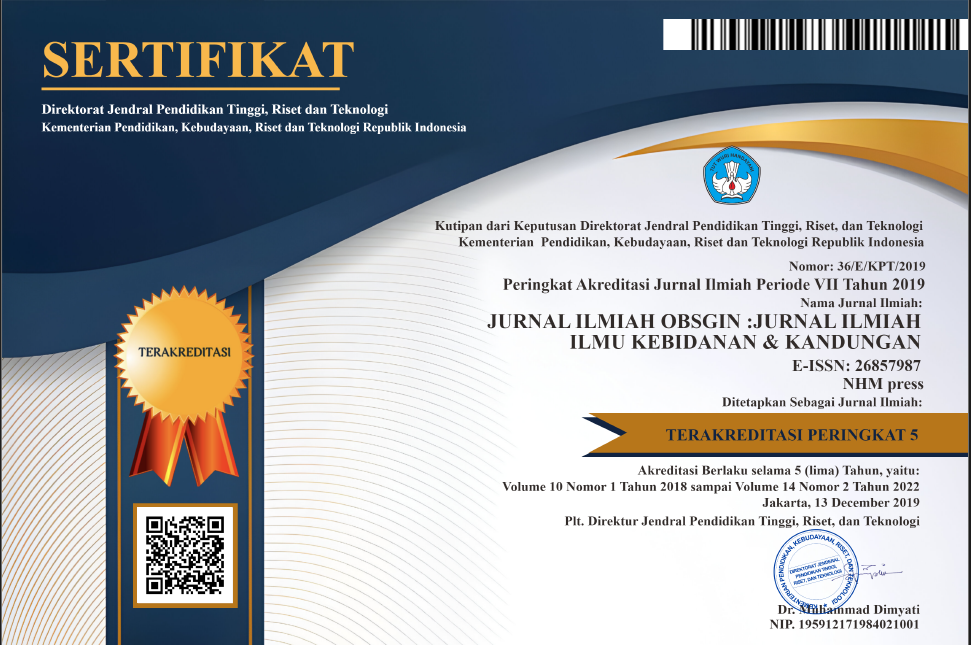HUBUNGAN MOTIVASI DALAM PENCEGAHAN KANKER SERVIKS DENGAN SIKAP UNTUK MELAKUKAN PEMERIKSAAN INSPEKSI VISUAL ASAM ASETAT PADA IBU USIA SUBUR DI WILAYAH KERJA PUSKESMAS RANDUAGUNG LUMAJANG
Abstract
Cervical cancer has become the leading cause of death from cancer among women. The IVA test can detect early cervical cancer by differentiating normal and abnormal cervix to identify precancerous lesions. This study aims to analyze the correlation between motivation in cervical cancer prevention and attitude to carry out a visual inspection of acetic acid in women of childbearing age in the Working Area of the Randuagung Lumajang Health Center. The research design used correlation with a cross-sectional approach. The population in this study were women of childbearing age involving 158 respondents. The sampling technique used is simple random sampling. Data were collected using the client motivation for therapy scale (CMOTS) questionnaire and attitude and practice toward cervical cancer.The data were analyzed using Predictive Analytics SoftWare Version 18 with the Spearman Rho test at a significance level of α<0.05. The results showed that women of childbearing age had weak motivation in preventing cervical cancer (67.1%) and had less attitude to carry out a visual inspection of acetic acid (67.7%). It is also known that there is a correlation between motivation in preventing cervical cancer and attitude to carry out a visual inspection of acetic acid in women of childbearing age (p-value = 0.000 (r) 0.741). Having good motivation about cervical cancer prevention is significantly and positively related to the mother's attitude towards cervical cancer screening. Therefore the findings of this review provide important clues that it is necessary to address the process of regulation of motivation and simultaneously consider individuals and correlation in the use of health services, in this case, involvement in examinations.
References
Ago, & Efiok. (2022). Sociodemographic and gynaecological factors that influence uptake of cervical cancer screening. A cross-sectional study in Calabar, Nigeria. African Health Sciences, 22(4).
Aoki, Yin, & Termrungruanglert. (2020). National screening programs for cervical cancer in Asian countries. Journal of Gynecologic Oncology, 31(3).
Azene. (2021). Visual inspection with acetic-acid (VIA) service utilization and associated factors among women in Hawassa city, southern Ethiopia: a community based cross-sectional study. Women’s Midlife Health, 6(7).
Azwar. (2021). Penyusunan Skala Psikologi. Pustaka Pelajar.
Bobak. (2018). Buku Ajar Keperawatan Maternitas. Penerbit Buku Kedokteran EGC.
Bossard, & Song. (2018). The Impact of Perceived Barriers on Self-Efficacy for HPV Preventive Behavior. Asia Pasific Journal of Cancer Prevention, 19(4).
Bray, & Ferlay. (2018). Global cancer statistics 2018: GLOBOCAN estimates of incidence and mortality worldwide for 36 cancers in 185 countries. A Cancer Journal for Clinicians, 68(6).
Bula, Lee, & Chopola. (2022). Perceptions of cervical cancer and motivation for screening among women in Rural Lilongwe, Malawi: A qualitative study. Plose One, 17(2).
Callahan, & Caughey. (2018). Blue Prints Obstetrics & Gynecology. Wolters Kluwer.
Chen. (2019). Effect of time interval from diagnosis to treatment for cervical cancer on survival: A nationwide cohort study. PLoS One, 14(9).
Daniel, & Miller. (2015). Human Papillomavirus (HPV)-Associated Oropharyngeal Cancer. Springer International Publishing.
Dinas Kesehatan Provinsi Jawa Timur. (2022). Profil Kesehatan Jawa Timur 2021. Dinas Kesehatan Provinsi Jawa Timur.
Donatus, & Nina. (2019). ssessing the uptake of cervical cancer screening among women aged 25-65 years in Kumbo West Health District, Cameroon. The Pan African Medical Journal, 33(106).
Eshetu, & Shitu. (2022). Predictors of intention to receive cervical cancer screening among commercial sex workers in Gondar city, northwest Ethiopia: application of the theory of planned behavior. BMC Part of Springer Nature BMC Women’s Health, 22(462).
Faradisa, & Ardiana. (2020). A Systematic Review of the Factors Associated with Cervical Cancer Screening Uptake among Women in Low and Middle-Income Countries. Jurnal Ners, 15(2).
Feebruanti. (2019). Asuhan Keperawatan pada Pasien Kanker Serviks. Deepublish Grup Penerbitan CV. Budi Utama.
Gerungan. (2018). Psikologi Sosial. Refika Aditama.
Gross, & Kinninson. (2018). Psychology for Nurses and Allied health Professionals. Routledge.
Hammer, & McPhee. (2019). Pathophysiology of Desease. McGraw- Hill Education.
Hidayat. (2020). Ilmu Perilaku Manusia: Pengantar Psikologi Untuk Tenaga Kesehatan. Gramedia Pustaka Utama.
Hosseeini, & Alavi. (2021). Scoping Review on the Concept of Patient Motivation and Practical Tools to Assess it. Iranian Journal of Nursing and Midwifery Research, 26(1).
Irwan. (2017). Etika dan Perilaku Kesehatan. CV. Absolute Media.
Johnson, & Deepthi. (2018). Cervical Cancer: An Overview of Pathophysiology and Management. Seminars in Oncology Nursing, 35(2).
Juwitasari, & Rosyad. (2021). Husband Support Mediates the Association between Self-Efficacy and Cervical Cancer Screening among Women in the Rural Area of Indonesia. Asia Pacific Journal of Oncology Nursing, 8(5).
Kashyap, & Krishnan. (2019). Risk Factors of Cervical Cancer: A Case-Control Study. Asia-Pasific Journal of Oncology Nursing, 6(3).
Khanna, & Khargekar. (2019). Knowledge, attitude, and practice about cervical cancer and its screening among community healthcare workers of Varanasi district, Uttar Pradesh, India. Journal of Family Medicine and Primary Care, 8(5).
Korn, & Muzingwani. (2022). Cervical cancer screening and treatment, HIV infection, and age: Program implementation in seven regions of Namibia. PLoS One, 17(2).
Kristina, & Endarti. (2022). Prediction of Productivity Costs Related to Cervical Cancer Mortality in Indonesia 2018. Malaysian Journal of Medical Sciences, 29(1).
Kumar, & Abbas. (2015). Pathologic Basis of Disease. Elsevier Saunders.
Lewis, L. (2018). Fundamentals of Midwifery. Wiley Blackwell.
Lin, & Chen. (2021). Cervical Cancer Screening Rate and Willingness among Female Migrants in Shenzhen, China: Three-Year Changes in Citywide Surveys. Cancer Research and Treatment, 53(1).
Lowdermilk, D. L., Perry, S. E., Cashion, K., Alden, K. R., & Olshansky, E. F. (2016). Maternity & Women’s Health Care. Elsevier, Ltd.
Madiuw, & Leutualy. (2022). Deteksi Risiko Kanker Serviks. Penerbit NEM.
Madiuw, Rahmawati, & Nurhidayah. (2022). Skrining Kanker Serviks. NEM.
Mahardita. (2018). Hubungan Stigma Masyarakat dengan Motivasi Sembuh pada Orang dengan Kusta di Kabupaten Jember. Universitas Jember.
Mattiuzzi. (2022). Cancer statistics: a comparison between World Health Organization (WHO) and Global Burden of Disease (GBD). European Journal of Public Health, 30(1026).
Mustafa, & Santesso. (2016). Systematic reviews and meta-analyses of the accuracy of HPV tests, visual inspection with acetic acid, cytology, and colposcopy. International Journal of Gynecology & Obstetrics, 132(3).
Namale, & Mayanja. (2021). Visual inspection with acetic acid (VIA) positivity among female sex workers: a cross-sectional study highlighting one-year experiences in early detection of pre-cancerous and cancerous cervical lesions in Kampala, Uganda. Infectious Agents and Cancer, 16(31).
Nathalia. (2020). Hubungan Pengetahuan Dengan Sikap Wanita Usia Subur Tentang Manfaat Iva Test Untuk Deteksi Dini Kanker Serviks Di Puskesmas Soreang. Jurnal Omiah Bidan, 5(2).
Nigussie, & Admasu. (2019). Cervical cancer screening service utilization and associated factors among age-eligible women in Jimma town using health belief model, South West Ethiopia. BMC Women’s Health, 19(1).
Notoadmodjo. (2017). Metodologi Penelitian Kesehatan. Rineka Cipta.
Notoadmodjo, S. (2014). Promosi Kesehatan dan Ilmu Perilaku. Rineka Cipta.
Nursalam. (2017a). Manajemen Keperawatan Aplikasi dalam Praktik Keperawatan Profesional (4th ed.). Salemba Medika.
Nursalam. (2017b). Metodologi Penelitian Ilmu Keperawatan: Pendekatan Praktis. Salemba Medika.
Nyambe, & Kampen. (2019). Knowledge, attitudes and practices of cervical cancer prevention among Zambian women and men. BMC Public Health, 19(508).
Okunowo, & Daramola. (2018). Women’s knowledge of cervical cancer and uptake of Pap smear testing and the factors influencing it in a Nigerian tertiary hospital. Journal of Cancer Research and Practice, 5(3).
Perkins, & Guido. (2020). Risk-Based Management Consensus Guidelines for Abnormal Cervical Cancer Screening Tests and Cancer Precursors. Journal of Lower Genital Tract Disease, 24(2).
Petersen, & Ginindza. (2022). Barriers to uptake of cervical cancer screening services in low-and-middle-income countries: a systematic review. BMC Women’s Health2, 22(486).
Roncancio, & Angelica. (2015). Using the Theory of Planned Behavior to Understand Cervical Cancer Screening among Latinas. Health Education & Behavior : The Official Publication of the Society for Public Health Education, 42(5).
Rustam. (2012). Sinopsis Obsteri. Penerbit Buku Kedokteran EGC.
Schacter, Gilbert, & Wegner. (2016). Psychology. Macmillan Palgrave.
Setiadi. (2016). Psikologi Positif Pendekatan Ssaintifik Menuju Kebahagiaan. Gramedia Pustaka Utama.
Silverman, & Hanrahan. (2016). Artificial Intelligence and Human Behavior Modeling and Simulation for Mental Health Conditions. Artificial Intelligence in Behavioral and Mental Health Care Artificial Intelligence in Behavioral and Mental Health Care, 163.
Simarmata. (2022). Kanker Serviks Pengetahuan Ibu Muda Usia. Yayasan kita Menulis.
Stephens, F. O., & Aigner, K. R. (2015). Basics of Oncology. In Basics of Oncology. Springer. https://doi.org/10.1007/978-3-319-23368-0
Sugiyono. (2017a). Metode Penelitian Kuantitatif Kualitatif dan R&D. Rineka Cipta.
Sugiyono. (2017b). Metode Penelitian Pendekatan Kuantitataif, Kualitatif, Kombinasi dan R&D. Alfabeta.
Sulistyawati, & Faizah. (2020). An Association Study of Cervical Cancer Correlated with The Age of Coitarche in Dr. Soetomo Hospital Surabaya. Indonesia Journal of Cancer, 14(1).
Sung, & Soerjomataram. (2021). Global cancer statistics 2020: GLOBOCAN estimates of incidence and mortality worldwide for 36 cancers in 185 countries. CA: A Cancer Journal for Clinicians, 71(209).
Surahman. (2016a). Metodologi Penelitian. Pusat Pendidikan Sumberdaya Manusia Kesehatan Kementerian Kesehatan RI.
Surahman. (2016b). Metodologi Penelitian. Badan Pengembangan dan Pemberdayaan Sumber Daya Kesehatan Kementerian Kesehatan Republik Indonesia.
Tekle, & Wolka. (2020). Knowledge, Attitude and Practice Towards Cervical Cancer Screening Among Women and Associated Factors in Hospitals of Wolaita Zone, Southern Ethiopia. Cancer Management and Research, 12(993).
The American Cancer Society. (2018). Priciples of Oncology Prevention to Survivorship. The American Cancer Society.
Wade, C., & Tavris, C. (2017). Psikologi. Penerbit Erlangga.
Wicthed, & Ghetti. (2018). Steven Handbook of experimental psychology and cognitive neuroscience. John Wiley & Sons, Inc.
Wirawan, S. (2018). Pengantar Psikologi Umum. Raja Grafindo Persada.
Woldetsadik. (2020). Socio-demographic characteristics and associated factors influencing cervical cancer screening among women attending in St. Paul’s Teaching and Referral Hospital, Ethiopia. BMC Women’s Health, 20(70).
Wollancho, & Amdissa. (2020). Determining behavioral intention and its predictors towards cervical cancer screening among women in Gomma district, Jimma, Ethiopia: Application of the theory of planned behavior. PLoS One, 5(11).
World Health Organization. (2022). Fact Sheet Cervical Cancer. Newsroom Fact Sheet WHO, 22(2).
Zhang, Xu, & Qiao. (2020). Cervical cancer: Epidemiology, risk factors and screening. Chinese Journal of Cancer Research, 32(6).











